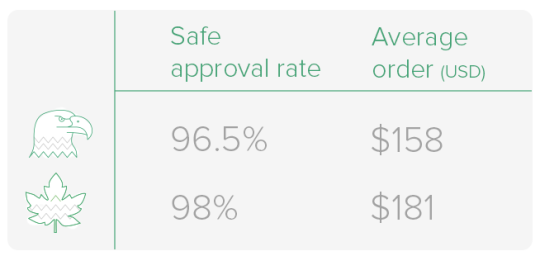By Andy Freedman, CMO at Riskified

July is big in North America. Canadians usher in the month with Canada Day festivities, and as their celebrations wane, Americans light up the grills and start celebrating the Fourth of July.
For many of us, telling Canadians and Americans apart is no easy task (unless they happen to utter a keyword like “about”). Canadians are often perceived as more polite and Americans as more animated. But when it comes to online shopping behaviors, there are more noticeable differences. To honor these two great nations on their holidays, Riskified provides insights into some lesser-known differences between the U.S. and Canada.
Shopping Behavior Or Shopping Behaviour?
Riskified processes millions of orders, so we can discern nuances in American and Canadian shopping behaviors. Comparing online orders where the credit card issuing country matches the shipping country, we found that Canadian consumers spend more. The average value of Canadians’ shopping carts is 15% higher than their neighbors to the south. Not only do Canadians spend more, but their orders are slightly safer: 98% of domestic Canadian orders were safely approved, compared to 96.5% of domestic US orders.

While Canadian orders are slightly safer, digital goods are an exception to this rule. In fact, digital gift card purchases made from a Canadian IP address carry an especially high risk of fraud: 14% of transactions are clear cut fraud, four times higher than U.S. e-gift card orders.
Another area where Canadian orders carry more risk is sporting equipment. Canadians love their sports, and apparently they are willing to go the extra mile to obtain gear. The fraud rate in Canada for this vertical is roughly three times higher than the U.S.
Location Is Everything (In Fraud)
Canada is the second largest country in the world, and the U.S. is the third. We analyzed our data to see how fraud patterns differ across the different states, provinces and territories.
The safest province in Canada is Prince Edward Island: we’ve never encountered fraud from there, or from Yukon! Even Ontario, Canada’s most populated province, is pretty safe, with 98.8% valid e-Commerce orders. Quebec has the most online fraud, yet merchants should be approving nearly nine out of every 10 orders from this province!
The top and bottom three provinces and territories in terms of safe approval rates:

In the U.S., online orders placed from Rhode Island are extremely safe, but the winners are members of the U.S. Armed Forces stationed in Europe, who boast a 99.5% safe approval rate. The states with the most online fraud are Delaware and Florida. Nonetheless, merchants can and should be approving at least 95% of online orders from these “risky” states.
The top and bottom three states in terms of safe approval rates:

Another interesting trend is the correlation between shipping distance and fraud. In both Canada and the U.S., as the distance between the shipping and billing addresses grows, the higher the fraud rate. The correlation is more pronounced in Canadian orders, where three out of every 10 orders with a difference of more than 200km between the shipping and billing addresses are fraudulent.
Approval rates for domestic orders:

The Devil Is In The Fine Details
Just like their national holidays (only three days apart) the differences between Americans and Canadians are probably smaller than some would like to admit. But for e-Commerce merchants, every boost in approval rate translates into revenue, and every false decline means a lost deal and a lost lifetime value of the insulted customer. The key to mastering fraud management lies in identifying the people behind the order and understanding the context of their purchases. Here’s wishing our American and Canadian friends happy and joyous independence days!
Andy Freedman is the CMO at Riskified, driving global market and demand strategy and strategic partnerships. He brings over a decade of branding, marketing and strategy expertise in building Riskified’s brand and marketing department. Prior to joining Riskified in 2014, Freedman served as the Vice President of Strategy and Revenue at LevelUp, leading strategic ventures and partnerships. Andy previously held multiple leadership roles at Fortune 500 companies, including Visa and General Mills. Andy received an MBA from the University of Wisconsin-Madison, and a B.B.A. in Marketing from Emory University.






